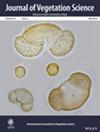Lost in Space: When Spatial Scale Terms Blur Actual Study Size in Plant Community Ecology
Abstract
Questions
The detection and interpretation of ecological processes are strongly influenced by the spatial scale at which studies are conducted. Scale terms (e.g., ‘local’ or ‘regional’) are frequently used to denote study scale and imply that studies using the same scale term should be directly comparable. However, whether the area encompassed by a particular scale term is consistent across studies remains unclear.
Location
Global.
Methods
We reviewed 385 papers in plant community ecology and analysed 962 spatial scale terms and their reported areas. We tested whether variation in the use of individual scale terms could be explained by habitat, type of study or geographic region, and virtually sampled a simulated plant community to demonstrate the consequences of this variation for calculating common biodiversity metrics.
Results
Single scale terms covered areas that vary by an average of 4.7 orders of magnitude, with significant overlap between distinct scale terms. Though this variation could be partly explained by habitat type (e.g., scale terms cover larger areas in forests than grasslands), we still found large variability (3.8 orders of magnitude) in the use of single terms within habitats. We also found overall high consistency (but still high variability) in the use of scale terms across geographic regions and study types. Our community simulation showed that Shannon's and Simpson's indices are highly sensitive to this variation, especially at finer spatial scales, suggesting that variation in the use of individual scale terms has major consequences for synthesising biodiversity trends.
Conclusions
While terminology can make it appear that studies are directly comparable, they may cover vastly different areas and capture different ecological processes. Spatial scales should be reported in a standardised fashion by clearly stating the actual study size in abstracts and methods, and inconsistencies in scale term use should be accounted for when synthesising previous research.


 求助内容:
求助内容: 应助结果提醒方式:
应助结果提醒方式:


